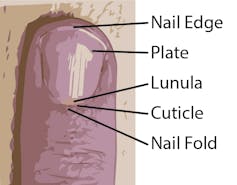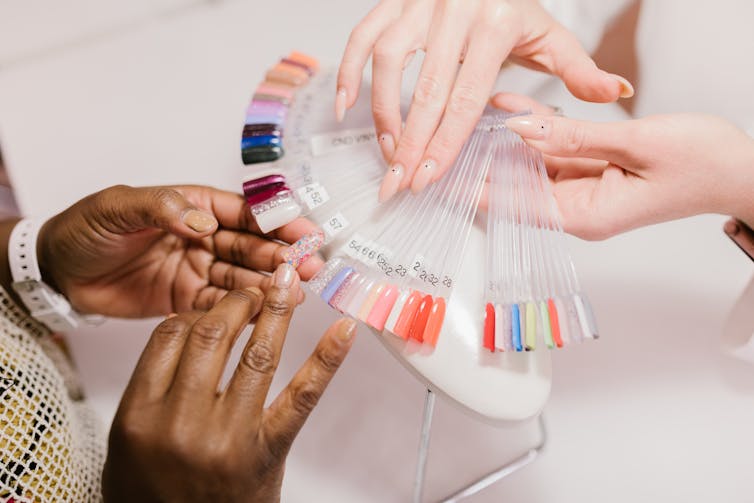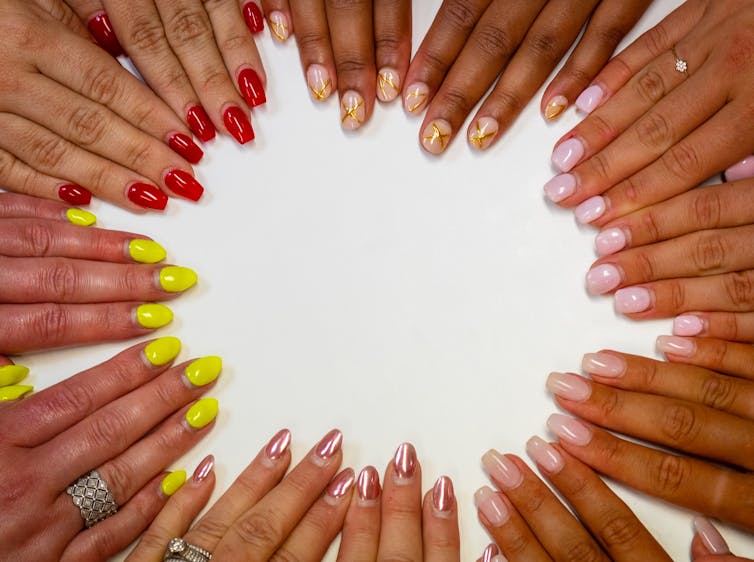People are increasingly opting for regular manicures – with vibrant layers of polish, gel, acrylic, or powder. Australians spend more than $22 billion a year on beauty treatments. And it’s not slowing down – the beauty and personal care market is expected to grow at around 2-5 percent% in the next year. Manicure popularity (velvet fingernails are among the latest looks) could be down to fashion, social media influencers, or our desire for small luxuries. But should you hold off from treatments, and give your fingernails a break every now and then?
What are fingernails?
Fingernails are a unique feature in primates, made from skin cells. A special arrangement of keratin, a structural protein, allows the nails to become strong and compact. Keratin is the same protein present in hair, as well as the horns, claws, and hooves of other animals. Upon maturing, the cells making up the fingernail disintegrate their nucleus, giving rise to a translucent and colorless appearance. Fingernails strengthen and protect the fingertips.
They enable fine motor control, such as turning the pages of a book or picking up a needle from a table. They allow us to scratch ourselves when itchy, hold a better grip on some items, and pry open nuts and foods. They also enhance some sensations due to the underlying nerves. The curved shape of the nail both strengthens it, as well as allows a nice snug fit to the underlying finger. Fingernails grow at an average rate of 3 millimeters per month, so it takes about 4-6 months to fully grow from the cuticle to the tip. This is much faster than toenails, which grow around three times slower.

Fingernails grow from the skin at the base of the nail, with the new nail slowly pushing the rest forward. This occurs the fastest up to about 14 years of age, with males exhibiting faster-growing nails than females. The growth rate evens out at around 50 years of age. Fingernails can be an insight into your health. An abnormally shaped nail bed (clubbing) may suggest anemia, low tissue oxygenation, or cardiovascular disease. Discoloration or pitting could indicate autoimmune issues, infections, or malnutrition.
How do nails break?
Dermatologists see a lot of patients with frail and brittle nails. Such nails can be vulnerable to splitting or breaking. The external environment does impact your nails. Both low moisture and very high moisture can cause the nails to become brittle. Poor nutrition and age can also affect the health of the nailbed and the strength and color of the nails.
Beautiful nails
Healthy nails are more likely to look good. Good habits to adopt for strong fingernails include trimming the nails straight across and rounding the edges, not messing with the cuticles (which help keep out nasty bugs), and not putting anything sharp under the nails. But of course, playing around with the look of nails using shades and colors can be fun and fashionable. Around 85-90 percent of women worldwide use nail care products.

Can manicures do damage?
Although cosmetics can enhance nail appearance, they can damage the underlying nails. Knowing what changes could occur is the important first step toward avoiding any permanent impact. If you regularly paint your fingernails with traditional nail polish, be careful when using darker colors as this can stain the nail plate. Some ingredients in nail care products may also lead to allergic contact dermatitis. To cure, harden, and dry each layer, the nail is often exposed to light under a fluorescent bulb. Most commonly, nail salons will use UV lamps, which require about five minutes of exposure per hand.
This can cause cell damage and aging of the skin. Current literature reports low skin cancer risk from UV lamp exposure. However, the recommendation is to apply a broad-spectrum sunscreen with SPF >30 before exposure. The most common method of removing gel polish is using acetone. The chemical can lead to brittle, dry, and rough fingernails and cause separation of the nail from the nail bed. Skin contact with acetone can also cause your skin to become dry, irritated, and cracked. Some damage can also be done by peeling off acrylic or gel nails.

Maybe don’t try this at home
Practicing beauty techniques at home comes with the danger of serious harm. The glue or chemical applicants used to adhere fake nails can cause serious burns. The chemicals used can also be harmful to children if left within reach. As such, going to a qualified and experienced nail technician is likely safer, provided they are taking infection precautions like using sterile tools and equipment. Although nail cosmetics come with relatively minor risks, dermatologists often recommend sticking with your natural nails and painting them with regular polish, and allowing intermittent breaks between manicures to give them time to breathe.
We use the term “breathe” loosely here. Your nails receive their nourishment from the blood vessels under the skin, and do not need contact with outside oxygen. But keeping them uncovered with product does give your body a chance to repair and regenerate your nails and the surrounding skin, keeping the region nice and healthy. How long of a break is up to you, depending on your nails. However, given a full nail regrows entirely in four to six months, you won’t need to wait that long.
This article is republished from The Conversation under a Creative Commons license. Read the original article.
Christian Moro, Associate Professor of Science & Medicine, Bond University, and Charlotte Phelps, Ph.D. Candidate, Centre for Urology Research, Bond University
Follow us on Twitter, Facebook, or Pinterest

